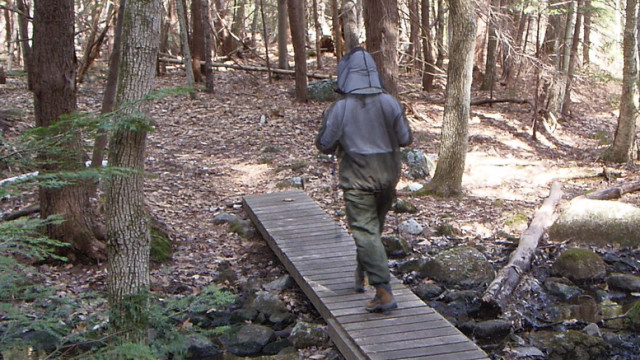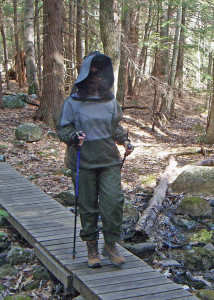
It’s probably the surest sign of spring in New England. Anywhere away from the city center and the immediate coast, we get a few warms days, the grass turns green, leaf buds unfurl, and suddenly, there’s a little cloud swirling about your head whenever you’re outside, and having fun. Yep, the black flies are out .
Don’t worry, though, they won’t last very long. Just long enough for the mosquitoes to get a running start.
Black flies—including all 50 species or so which inhabit New England—are classified in the family Simuliidae. At any one point, you can have 10 or more species flourishing in any given area. But does it really matter to you which particular species of black fly is swarming around your eyes or gnawing on your skin seeking the blood beneath? I didn’t think so . . .
Most years, blackflies will start earliest and disappear first in the south, linger longer the farther north you go.
Unlike mosquitoes, which breed in stagnant and, often, polluted pools and puddles, black flies only breed in clear, running water So, that’s one reason to appreciate black flies; If you see them, you know there’s clean, flowing water somewhere nearby. Unfortunately, it doesn’t mean right nearby. Black flies can travel miles, especially with a tail-wind.
Black flies feed by rasping a hole in your skin and sucking up the blood as it pools. Mosquitoes, of course, have a hypodermic needle attached and can penetrate thin clothing to feed. That makes it slightly easier to defend your fortress against blackflies.
Another fact, for what it’s worth: Only female black flies and mosquitoes feed on blood. They do it so they can lay eggs without being fertilized by a male. The males are harmless plant feeders. Warning to guys: This is not something to bring up if your wife or girlfriend is complaining about being bitten.
The trick, of course, is not to get bitten.
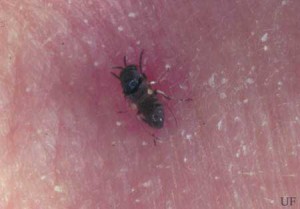
Biting flies like blackflies, deerflies and noseeums can be annoying. Enough of them can ruin an outdoor outing if you aren’t prepared. Mosquitoes and ticks are another matter. In addition to annoying, they can be genuinely dangerous, carrying bad stuff like EEE (Eastern Equine Encephalitis) and Lyme Disease, plus some slightly lesser baddies like West Nile Virus and Rocky Mountain Spotted Fever. None of these diseases have current vaccines, some of them don’t even have effective cures. Fortunately, none are common, and many people who are exposed to EEE and West Nile never get sick at all. All these diseases can be avoided totally by avoiding mosquito and tick bites.
No you don’t need to stay indoors for the whole summer. Just use a few common-sense precautions which I call the AAA Bug Strategy: Avoidance, Alchemy and Armor. This strategy is flexible enough for any situation and will keep you bite-free no matter how fierce the bugs get.
Here are some basic tips for escaping bug bites:
Basic Cures For Bug Problems: AVOIDANCE

1) KEEP MOVING! Most biting insects will follow a moving target but they rarely land and bite. This is a wonderful excuse to avoid anything sedentary, like gardening or lawn care, and do something more active and more fun. Biking is an ideal bite-avoidance strategy — even speedy deerflies have trouble keeping up with a cyclist, and blackflies and mosquitoes are slowpokes. Hiking at a brisk pace is usually enough to keep you relatively bite free. Canoeing and kayaking out on a breezy pond or down a flowing river also works well – at least until you have to come to shore.
2) CHOOSE YOUR BATTLEGROUND: There are places that biting bugs like a lot, and places they don’t do so well. Mosquitoes, which breed best in stagnant water, like swampy areas and tidal marshes. Obviously, it pays to approach these areas with caution if you don’t want to be bitten. Blackflies, by contrast, breed only in clean, unpolluted, moving water. In fact, the presence of blackflies is one indication that you’ve left some of the worst ravages of civilization behind! But blackflies can also travel several miles from where they are hatched, so you can get swarmed even if there isn’t any running water handy.
Ticks are another matter. they lie in wait on grass and low bushes and latch onto any passing critter–including you. Avoiding brush and tall grass as much as possible will help you avoid ticks.
3) LET THE BREEZES BLOW: Mosquitoes and black flies disperse in even a light breeze; a wind puts them entirely out of commission. Standing still in moving air is just as effective as being a moving target. Up in the far north of Quebec and Labrador, where blackflies and mosquitoes can appear in mind-numbing numbers, caribou stay on dry breezy hilltops as much as possible. Whenever possible, keep to open, windy areas and higher ground; This is a wonderful excuse to climb a mountain.
4) TIMING IS (ALMOST) EVERYTHING In spring, when blackflies are your main concern, get out early in the day: black flies are generally inactive until the air temperature has risen to at least 50 degrees. Later on in the season, mosquitoes and no-see-ums are most active on cooler, damper mornings and evenings and after dark. Deer flies and greenheads seem to love the heat of a summer day . . .
Basic Cures For Bug Problems: ALCHEMY
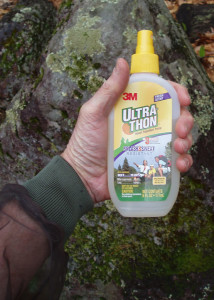
However much you dislike the thought of slathering chemicals on your skin, there are times when you just have to use insect repellent. When I need to keep bugs away, I use an insect repellent with DEET (N,N-diethyl-m toluamide). My research and 40+ years of experience leads me to believe that DEET is safe, but you’ll have to make your own judgement. You can find more information (which you can choose to trust or not) at deetonline.org, and deet.com.
Just be careful—a strong dose of concentrated DEET can make some rubber or plastic (such as the armoring on your binoculars) disappear. Use the lowest concentration you can get away with and put it on the backs of your hands—blackflies rarely attack palms.
If I need repellent, I use one with at least 15 percent DEET, which repels all biting insects, including ticks. Lately I’ve been using 3M’s “Ultrathon” pump spray and cream which have DEET in a timed-release formula and really do work for 12 hours as advertised.
There are of course natural alternatives to DEET. In my experience, they either don’t work at all or require such frequent re-application that they aren’t practical. If you’ve found one that actually works, please let me know. The EasternSlopes.com gang will test it and we’ll share the results with everyone.
The one exception I know of to the no DEET rule is Avon Skin So Soft which smells so bad it could gag a vulture, but works pretty well on black flies, not at all on mosquitoes. I don’t know if it stops ticks.
Basic Cures For Bug Problems: ARMOR
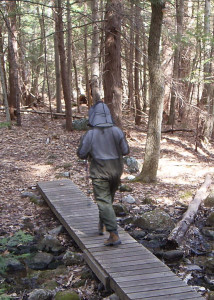
Clothing is an important part of your defense against being bitten by bugs. When insects are a threat, wear a light-colored long-sleeved shirt and pants with full legs, preferably with cuffs that can be cinched down tight enough to prevent ticks from crawling underneath. Or, tuck your pants cuffs into your socks.
With blackflies and ticks, socks, long pants (or, better yet, a very thin lightweight long base layer) , and a long-sleeved shirt augmented with a simple headnet you can wear over a baseball cap and some DEET-based insect repellent on your hands, you are good to go–most of the time.
Unfortunately, mosquitoes can drill right through thin cloth — especially where it’s stretched tight. If the weather is cool enough, you can solve this with two light layers – the movement of one layer of clothing over the other foils mosquitoes—as long as you are moving.
But if you are going to be still at all, you need even more armor. For hiking in insect season, we all now swear by Insect Shield clothing (made by several manufacturers including Ex Officio) which is treated with a chemical repellent which seems to solve the mosquito dilemma.
Another solution is a polyester mesh “bug suit” which you can wear over your regular clothing. The ones we use are made in the USA by Bug Baffler. Polyester mesh is lightweight, extraordinarily tough—much tougher than nylon. And, it has enough “body” to stand away from your skin unless you pull it tight, providing a barrier from even stabbers and stingers like mosquitoes and bees. It’s also totally breathable and won’t interfere with your movement.
Marilyn and I also both swear by the Original Bug Shirt, particularly for paddling when the mosquitoes are out. This shirt is made in Canada and uses a tightly woven, mosquito-proof fabric where it touches your skin, and mesh everywhere else for ventilation. It also provides sun protection which mesh suits don’t.
Bug suits are overkill most of the time. The exceptions are blackfly season in the northcountry and saltwater marshes and beaches in the evening when the mosquitoes and noseeums can plague you to the point of insanity. To be completely protected, you are going to need a hooded jacket with a headnets, pants, and mitts or gloves. A lot of the time, though, a headnet will be sufficient.


